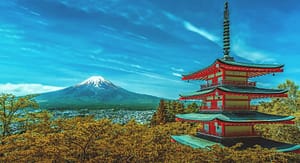Shokudō
Shokudō are casual, inexpensive eateries that serve homey meals – similar to what might be called a greasy spoon cafe or diner in the United States. These offer quick and easy meals and usually enough variety to please everyone (including children). Shokudō are everywhere, and especially near train stations and tourist sights. They often have plastic food models displayed in their window; in a pinch, if there’s no English menu, beckon the wait staff outside and point to what you want.
One thing to order at a shokudō is a teishoku, a set meal with one main dish (such as grilled fish) along with rice, miso soup and pickles. Other likely menu items include various donburi or; large bowls of rice with meat or fish piled on top) and katsu dishes, where the main is crumbed and deep fried.
Izakaya
Izakaya (居酒屋) translates as ‘drinking house’ – the Japanese equivalent of a pub – and you’ll find them all over Japan. Visiting one is a great way to dig into Japanese culture. An evening at an izakaya is dinner and drinks all in one: food is ordered for the table a few dishes at a time along with rounds of beer, sake or shōchū (a strong distilled alcohol often made from potatoes). While the vibe is lively and social, it’s perfectly acceptable to go by yourself and sit at the counter. If you don’t want alcohol, it’s fine to order a soft drink instead (but it would be strange to not order at least one drink).
Sushi
Sushi (寿司 or 鮨) is raw fish and rice seasoned with vinegar. Today sushi is widely associated with fresh fish, but the dish originated as a way to make fish last longer – the vinegar in the rice was a preserving agent. Older styles of sushi were designed to last for days, and have that heavy tang of fermentation. These include hako-zushi or oshi-zushi (‘box’ or ‘pressed’ sushi), made by pressing fish onto a bed of heavily vinegared rice in a wooden mould with a weighted top; sushi in this style is still eaten frequently in western Japan.
Tempura
Tempura is seafood (fish, eel or prawns) and vegetables (like pumpkin, green pepper, sweet potato or onion) lightly battered and deep-fried in sesame oil. Season by dipping each piece lightly in salt or a bowl of ten-tsuyu (broth for tempura) mixed with grated daikon (Japanese radish).
At a speciality restaurant, tempura is served as a set (all at once, with rice and soup) or as a course, with pieces delivered one at a time freshly cooked; you can order extras on top of the set or course, but rarely just à la carte.
Tonkatsu
Tonkatsu is a pork cutlet breaded in panko and deep-fried, almost always served as a set meal that includes rice, miso soup and a heaping mound of shredded cabbage. Season with tonkatsu sauce, a curious (and highly addictive) ketchup-y condiment, or karashi (hot spicy yellow mustard). At around ¥1000 to ¥2000 a meal, it’s perfect for when you want something hearty and filling. The best tonkatsu is said to be made from kurobuta (Black Berkshire pork), from Kagoshima.
Okonomiyaki
Okonomiyaki is a dish that flies in the face of the prevailing image of Japanese food being subtle. It’s a thick, savoury pancake stuffed with pork, squid, cabbage, cheese, mochi (pounded rice cake) – anything really (okonomi means ‘as you like’; yaki means ‘fry’). Once cooked, it’s seasoned with katsuo-bushi (bonito flakes), shōyu (soy sauce), ao-nori (green laver), a tonkatsu sauce and mayonnaise.
Kaiseki
Kaiseki is Japan’s formal haute cuisine, where ingredients, preparation, setting and presentation come together to create a highly ritualised, aesthetically sophisticated dining experience. Key to kaiseki is peak seasonal freshness; as the ingredients should be at the height of their flavour, only subtle seasoning is used to enhance them. The table settings and garnishes too are chosen to complement the ingredients and evoke seasonality.
Sweets
Sweets in Japan are traditionally considered an accompaniment for tea, though many restaurants have adopted the custom of dessert and end a meal with a serving of sliced fruit or maybe ice cream. Japanese confections are known generically as wagashi (as opposed to yōgashi, Western-style sweets like cake and cookies). The basic ingredients are just rice and a sweetened paste of red azuki beans (called anko). Flavour (usually subtle) and design (often exquisite) are influenced by the seasons. In spring they may be shaped like cherry blossoms or wrapped in cherry leaves; in autumn they might be golden coloured, like the leaves, or flavoured with chestnut.

